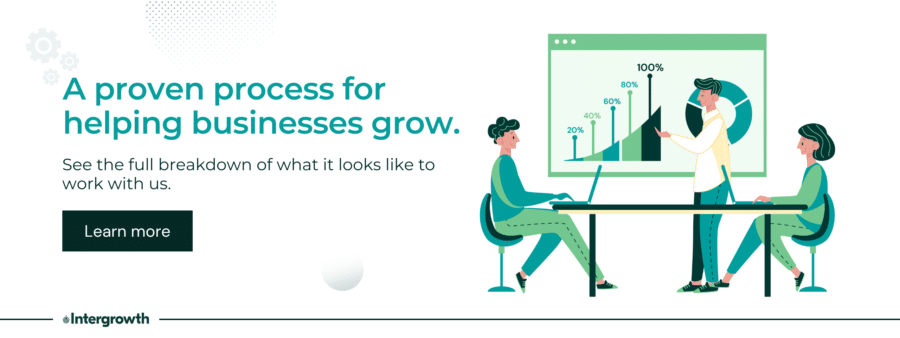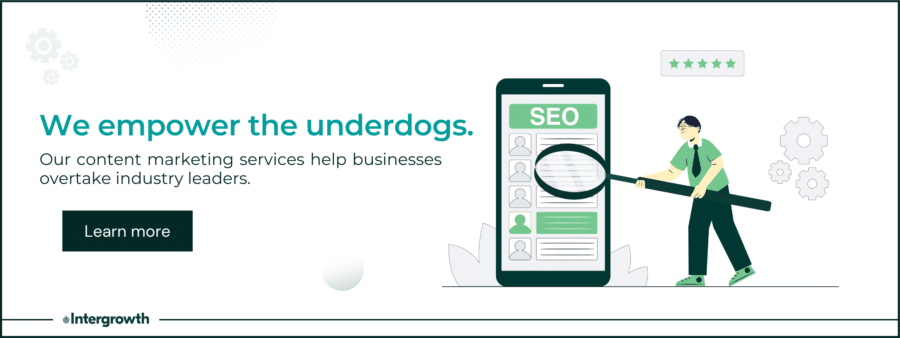After all, you don’t just want people to read one blog post then bounce from your site forever. You want them to share it with their network, follow you on social media, and read every new post you put out.
It’s kind of like being a musician. You don’t want to be a one-hit-wonder — you want a loyal audience who pre-orders each new album, buys tickets to your shows, and knows every word to every song.
Engaged visitors are far more likely to convert into paying customers. They’re also more likely to share your content with their network, which gets your brand name out there and can expand your audience.
Let’s get into it a little deeper. We’ll expand on why a loyal audience is so valuable for marketers and how you can build an audience development strategy of your own.
Casual Visitors vs. Engaged Audiences
Casual visitors are the ones who stumble upon your site (either through search or by clicking a backlink somewhere else) and putter around for a while before heading elsewhere.
Casual visitors are valuable, and anyone who makes content gets more casual visitors than loyal followers. The goal, however, is to convert those casuals into engaged followers.
Engaged audiences are those who actively seek out your content. They might bookmark your site and check back regularly, subscribe to your mailing list, or follow you on social media. These are the folks who are most interested in your brand and, therefore, most likely to buy your products or share your content with others.
In other words, engaged audiences carry a ton of value not only in the form of sales but in generating brand awareness through word-of-mouth referrals.
P.S. ReferralCandy is a great tool to explore for scaling up your word-of-mouth referrals from existing customers.
All casual visitors have the potential to turn into engaged audience members. A lot of them won’t (the average website has a clickthrough rate of 3.53% on calls-to-action), but some of them will. And the more you expand your visibility online and drive traffic to your site, the more engagement you’ll start to see.
The Value of an Engaged Audience
OptinMonster tells us that the average email marketing campaign gets a 22.86% open rate. Recipients are opening almost a quarter of all the marketing emails they receive.
And once people are opening your emails, you can share all kinds of information with them that they might not see otherwise. You can update them about new products, direct them towards new content on your website, and share discounts and promotions to encourage purchases.
Without that type of engagement, you’ll have to depend on people actively seeking out new content on your website. There will always be a certain audience segment that interacts with your site in that way, but it helps if you can nudge them to check out your new products or look at your new content.
Related: Building a Strategic Marketing Plan
How to Build an Audience Development Strategy
Here’s what you need to do to start building an audience and reaping the benefits of audience engagement:
1. Identify Your Target Audience
Every business has an ideal client. It’s the person who will get the maximum benefit from your product and who can afford it. Companies use their ideal client profile in deciding who to target with their marketing strategy.
Audience development is a way to attract those ideal clients — it’s a way to fill the sales funnel to the brim, so to speak. Not all of the new audience members you generate through your development efforts will fit your ideal client profile, but some of them will, and those folks will trickle down the funnel through the conversion process.
So, it’s important to identify the specific audience you want to target. Here are some things to think about:
Who They Are
What industry do they work in? What are their interests? How old are they and how much money do they make?
You’ve likely already answered these questions when building your business, but they’ll help you in your efforts to build an online audience.
What Problems Do They Face (That You Can Solve)?
The best way to build an audience is to provide valuable content. Whether you publish blogs, record podcasts, or make YouTube videos, your content should solve someone’s problem.
Think about the questions you can answer for people online. What type of information are your ideal customers looking for? Those are the types of questions you want to answer in your content.
Example: At Intergrowth, our ideal clients are often looking for info about content marketing and SEO. So, we create content around topics like this:
Where Do They Spend Time Online?
Meet your audience where they live. To find potential customers, you should post content where they’re most likely to find it.
Companies in the fashion industry, for instance, are most likely to find customers on visual platforms like Pinterest and Instagram. Other companies focus on blogging, tweeting, or podcasting.
Most audience development teams publish content on several platforms, or at least promote their main channel on multiple platforms (ex. using Twitter to promote your blog or syncing your YouTube channel with your Facebook page for cross-promotion).
2. Get Their Attention
Once you know who your audience is, where they spend their time online, and the type of problems they face, you can start creating content to address their needs.
Search engine optimization, or SEO, is helpful here. By researching the types of content your ideal customers are searching for and how they’re searching for that content (as in which words they’re typing into the search bar), you can gain a competitive edge over other creators making similar content.
Want to optimize your website and blogs for search engines? Let’s schedule a call to see if we can help.
3. Figure Out a Way to Keep Them Engaged
Strong content will keep some visitors coming back, but not enough to qualify as an “audience.” You won’t get as much value from your content if you have to depend on the virality of each individual piece to bring in new potential customers.
So, you have to figure out a way to stay in touch with them. The most common options are social media (“Follow us on LinkedIn!”) and your email list.
While both social media and mailing lists are great ways to build an audience, email tends to work better for companies who sell products and services. Twitter, Instagram, and other social platforms work well as audience development tools for influencers, but most companies see the greatest return from email subscriptions.
As Campaign Monitor points out in their blog, while the average email clickthrough rate is only around 3%, the average clickthrough rate for promotional tweets is far lower — only 0.5%.
How to Get People to Subscribe to Your Email List
The best way to get people to hand over their email addresses is to offer them something in return.
Many companies trade access to gated content, such as:
- eBooks
- White papers
- Webinars
- Online courses
These types of content work well as subscription incentives because anyone who wants access to them is clearly interested in your industry. They have questions that you have the answer to, which means that they likely have problems your product or service can solve.
If you’re strategic about the type of gated content you create, you won’t just attract an audience, you’ll attract the right audience.
4. Create a Content Calendar
To the outside world, it’ll look like you’re just creating content whenever inspiration hits and publishing it for everyone to see. But good content takes time to plan and effort to create, especially if you have a team of others helping you.
Make sure that you consistently have content in the works and going live by creating a content calendar.
A content calendar will outline the basic traits of each piece of content, such as:
Content type: Blog, social media post, marketing email, etc
Description: 1-2 sentences about the content topic
Owner(s): The person or persons in charge of creating the content
Target publication date: When you want the content to go live
It’s very simple, but it’ll keep you on track as you work to build your audience. By planning a few months in advance, you’ll ensure that you’re always getting content in front of potential audiences and satisfying your existing audience.
Audience Development Tools
Software isn’t going to help you create good content, but it will help you learn about your target audience. It’ll help you measure your audience development efforts, too, so you know if you’re making the right moves.
Here are some of the apps our editorial team uses for audience development:
Topic Analysis Tools
These tools will show you how your target audience behaves online. They’ll show you the types of keywords your audience is searching for, and you can use those keywords as the basis for your content.
Here are a few popular tools to help you with topic analysis:
1. Ahrefs
Ahrefs is a software suite built for SEO specialists. Not only will it help you with keyword research, but it’ll show you data about your competitors’ websites, keywords their site ranks for, etc.
2. SEMRush
SEMRush is a similar product to Ahrefs in that it’s designed primarily for keyword and backlink research. It allows you to plug in long lists of potential keywords so you can see which one will drive the most traffic to your site or channel.
3. AnswerThePublic
AnswerthePublic shows you all of the Google searches that contain a particular word. If you create content about cheeseburgers, for example, you can type that word in and get a list of common cheeseburger-related searches. It’s another way of seeing what people are searching for, and it can be helpful in generating content and keyword ideas.
4. Quora
Quora is a website people use to ask questions, kind of like Reddit but without the social media aspect. Each question is cataloged on an individual page, and you can browse through these pages by topic. If people are turning to Quora to learn about a particular topic, it means there could be a lack of good content about that topic, and there’s a gap that you could fill.
Content Management Systems
If you’re trying to build an audience purely on social media, you’ll use your social platform of choice to publish content. But if you want to build an audience through your website, you’ll need a content management system. This is the app you use to publish your content to the internet.
There are a million different CMS apps you could use, but these three are pretty popular right now:
1. WordPress
WordPress is generally considered the leader in terms of content management. It’s a super versatile tool that, with a bit of coding knowledge, you can use to build any type of website you like.
2. Shopify
Shopify is a CMS designed for ecommerce businesses. It allows you to manage your online store and your blog from one (kind of) easy-to-use platform. Like WordPress, it has all kinds of plug-ins and widgets you can use to optimize your site, including some Shopify blog templates to help you get started.
3. Squarespace and Wix
Squarespace and Wix are both simple CMS apps designed for the average user. You can’t do nearly as much with these website builders you can with WordPress or Shopify, but they’re great if you just want to create a simple website and publish it ASAP.
Analytics Software
The key to audience development is tracking the success of each project. When you can see what’s working and what’s not, you’ll have a better idea about how to move forward.
Here are some of the best tools for measuring the success of your content:
1. Google Analytics
Google Analytics shows you how your website visitors engage with your site. It shows when they visited, which page they entered the site from, and how long they spent browsing. You can also learn basic demographic information about each visitor, such as their age, gender, and geographic location, which will tell you if you’re reaching your target audience (or if you need to rethink who your target audience actually is).
2. Google Search Console
Google Search Console lets you track how your content performs in Google searches. It tells you which searches your site shows up in, how often searchers click your link for those searches, and more. It’s very helpful in showing you whether or not your site is ranking for the searches you’re targeting.
3. SEMRush and Ahrefs
SEMRush and Ahrefs aren’t just keyword research tools — they’re also keyword tracking tools. They’ll track which keywords your site ranks for and how your rankings improve over time. These apps also have features that track your ranking in comparison to your competitors’ rankings for the same keywords, so you’ll know what topics you need to put more effort into.
Conclusion
No matter what your business goals may be, an engaged audience is the key to sustainable success. You can have some short-term success without an audience, but it’s unlikely to last very long.
Again, think of yourself as a musician:
You don’t just want people to turn the radio up when your song comes on — you want them to buy merch, drive ticket sales, and tell their friends about your band.
If you can do that, your business will be in a much better position.
If this sounds like a lot to put on your own plate, reach out to us. Our SEO experts and content marketing specialists can hel you to increase your audience engagement and help you scale your business.
SCALE YOUR ORGANIC TRAFFIC
Subscribe to our monthly newsletter





